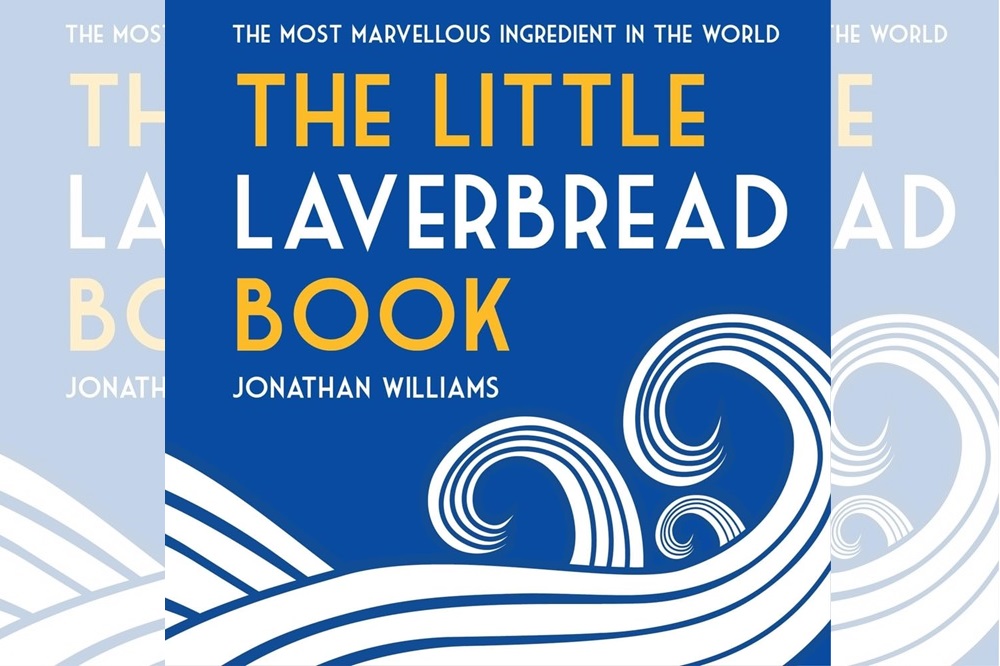Book review: The Little Laverbread Book by Jonathan Williams

Jon Gower
Laverbread is the marine equivalent to Marmite: it has both its devotees and its detractors.
For the latter it’s a mucilaginous, greeny-black gunk which is about as appetising as eating sump oil. Boiled seaweed? No fear.
But for the faithful, such as author and seaweed entrepreneur Jonathan Williams, it’s quite something else.
He nails his colours firmly to the mast in the sub-heading for the book in which he announces it to be ‘The Most Marvellous Ingredient in the World.’
Umami
I agree with the author entirely when he suggests that laverbread has the quality called umami by the Japanese, the very essence of deliciousness.
For me it is the very taste of the sea and carries with it memories of growing up on the edge of the Burry estuary when it was the perfect complement to the cockles we would pick for ourselves, raking them out of the sands before washing them three times.
Yet I know from my own family that laverbread divides opinions: in a casual, empirical survey I’m the 25% of the household that enjoys laverbread, while the other three quarters wrinkle their noses in disgust when I use it for breakfast.
Health-giving
The beautifully-produced Little Laverbread Book is part recipe book, part memoir, part history, part legend and constitutes a homage on the part of its author, a former beach bum who has built three businesses from laverbread, being Café Môr, The Pembrokeshire Beach Food Company and Barti Ddu Rum.
In it he tells us how the name derives from the days when laverbread was produced by grinding seaweed on a stone, in a process not dissimilar to making flour.
The resulting food item has long been said to have health giving properties: as far back as 1695 a letter in William Camden’s Brittania asserts that, eaten raw, or ‘fry’d with oatmeal and butter’ ‘accounted sovereign against all distempers of the liver and spleen.’
This seaweed contains more vitamins and minerals that any land-based vegetable, containing ten times as much vitamin A as spinach and four times as much vitamin C as apples.
It is rich in potassium, manganese, iron, calcium, iodine and contains more protein than the equivalent weight of chicken or tuna.
Shipwreck
Collecting laverbread was once a much bigger concern in Wales, with dedicated drying huts, such as those found and photographed in Freshwater West in Pembrokeshire in the 1950s.
Now only one of these remains to denote what was once a busy and thriving laver seaweed picking area.
For those used to buying their laverbread at the central counter of Swansea Market there’s a fascinating story recounted by Williams, which tells of a very specific and dramatic connection between the city and seaweed.
It dates back to January 1979 when a ship called the Thomas M.Reed, on its maiden voyage out of the American port of Bath in Maine struck a reef off Frainslake Bay on the southwest tip of Pembrokeshire.
It was carrying a lot of very precious cargo including 1000 tons of Columbia River Salmon ansd the same amount of Californian Wheat as well as cases of beef, preserved fruits and sacks of mother of pearl shells, lead ore and large quantities of copper.
News of the 15,000 boxes of goods that had been washed up on the shore at Freshwater West spread quickly across south Wales, attracting treasure hunters from as far away as Swansea.
Those, in particular, found other bounty on the shore, and struck up a deal with the inhabitants of Angle to buy as much seaweed as they could humanly collect.
Truffles
In its heyday laverbread was not only popular in the coal-mining communities of the south Wales valleys but also made it to the tables of London’s gentlemen’s clubs, where the famous French chef Alexis Soyer would use it as a constituent of ramifolles which were served at the Reform Club.
But its popularity, like the tide that washes the ocean facing rocks on which this seaweed grows, eventually ebbed away, with the Victorian critic Eneas Dallas bemoaning the fact that had French cooks had ruled English clubs they would have made laverbread ‘as famous as the truffles of Perigord.’
Sushi
We also learn about Kathleen Mary Drew-Baker, the British phycologist and so-called Mother of the Sea, whose discoveries about the life cycle of laver seaweed helped save the Japanese laver industry from collapse, in so doing leading to what is today the richest form of aquaculture in the world, supplying the basic ingredient of sushi rolls the world over.
Mouth-watering
The second half of The Little Book of Laverbread is devoted to easy to use recipes, accompanied by mouth-watering photographs by Huw Jones, aided by the food styling skills of Paul Lane.
So we have laverbread scones and laverbread tempura tacos, miso soup and sourdough bread, not to mention the delicious-sounding butternut squash, laverbread and coconut curry, stairway to heaven linguine and aubergine parmigiana with laverbread and lentils.
It all serves to underline the ubiquitous qualities of this quintessentially natural ingredient, washed by the waves and picked off the sea-rocks.
Jonathan Williams is a great advocate for its delights and this book may well change some long-held opinions. For those already sold on the stuff it is like a small bit of bounty, a lovely little book about a tasty Welsh treasure.
The Little Laverbread Book by Jonathan Williams is published by Graffeg and is available from all good bookshops.
Support our Nation today
For the price of a cup of coffee a month you can help us create an independent, not-for-profit, national news service for the people of Wales, by the people of Wales.




